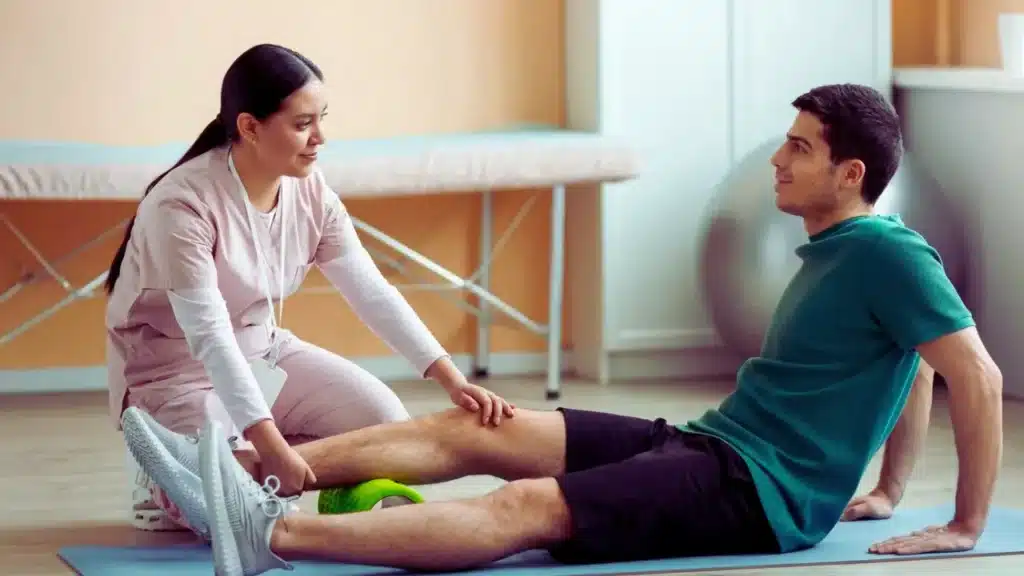Ulnar nerve entrapment can cause discomfort, weakness, and numbness in the hand and forearm. This condition occurs when the ulnar nerve is compressed, leading to symptoms that may worsen if left untreated. Incorporating specific exercises can help relieve pain, restore mobility, and prevent further complications.
Ulnar nerve entrapment can cause discomfort, numbness, and weakness in the hand and forearm, making everyday tasks difficult. Whether the compression occurs at the elbow (cubital tunnel syndrome) or wrist (Guyon’s canal syndrome), targeted exercises can help alleviate pain and restore function. By incorporating gentle stretches and strengthening movements, you can reduce nerve irritation, improve mobility, and support long-term recovery. Before beginning any exercise routine, it’s essential to consult a healthcare professional to ensure the movements are appropriate for your condition.
What is Ulnar Nerve Entrapment?
Ulnar nerve entrapment occurs when the ulnar nerve, which runs from the neck down to the hand, gets compressed at the elbow or wrist. It is commonly referred to as cubital tunnel syndrome when it affects the elbow and Guyon’s canal syndrome when it occurs at the wrist.
This can cause numbness, tingling, and weakness in the ring and little fingers, affecting hand function. The condition is commonly linked to prolonged elbow flexion, repetitive movements, or direct pressure on the nerve. Symptoms may worsen over time, leading to muscle weakness and coordination issues. Early treatment with exercises, bracing, and lifestyle changes can help manage and prevent its progression.
Common Symptoms of Ulnar Nerve Entrapment
Common symptoms include numbness and tingling in the ring and little fingers, often worsening at night. Weakness in the hand may make gripping objects or performing fine motor tasks difficult. Some people experience a feeling of clumsiness or loss of coordination in the fingers. In severe cases, muscle wasting in the hand, particularly near the thumb, can occur. Persistent symptoms may indicate progressive nerve damage and require medical attention.
| Symptom | Description |
| Numbness & Tingling | Affects the ring and little fingers |
| Weak Grip Strength | Difficulty holding objects firmly |
| Hand Clumsiness | Trouble with fine motor skills |
| Muscle Atrophy | Wasting of hand muscles in severe cases |
| Pain Along the Arm | An aching or burning sensation extending from elbow to hand |
Causes of Ulnar Nerve Entrapment
Ulnar nerve entrapment is often caused by prolonged elbow bending, which puts pressure on the nerve. Repetitive movements, such as typing or lifting, can lead to irritation and compression. Direct trauma or prolonged pressure on the elbow, like resting it on hard surfaces, may worsen the condition. Certain medical conditions, including arthritis and diabetes, can increase the risk of nerve compression. Structural abnormalities or past injuries can also contribute to nerve entrapment.
- Repetitive elbow bending
- Prolonged pressure on the elbow or wrist
- Bone fractures or arthritis
- Swelling due to injury
- Congenital anatomical differences
How Exercises Help in Pain Recovery

Targeted exercises improve flexibility, reduce compression, and enhance nerve gliding. Strengthening the surrounding muscles also reduces the strain on the nerve. Exercises improve blood circulation, reducing inflammation and promoting nerve healing. Stretching and mobility exercises relieve tension, allowing the ulnar nerve to glide smoothly. Strengthening surrounding muscles provides better support, reducing pressure on the nerve. Consistent movement prevents stiffness and enhances overall hand and arm function. Regular exercise can accelerate recovery and minimize the risk of recurring pain.
Benefits of Ulnar Nerve Entrapment Exercises
Ulnar nerve entrapment exercises help reduce nerve compression and relieve pain. Regular stretching and mobility exercises improve flexibility and prevent stiffness. Strengthening surrounding muscles provides better support, reducing strain on the nerve. Nerve gliding techniques enhance movement and promote healing by improving circulation. Consistent practice can prevent symptom progression and reduce the need for medical intervention.
| Benefit | Description |
| Improved Mobility | Enhances the range of motion in the elbow and wrist |
| Pain Relief | Reduces nerve compression and discomfort |
| Stronger Muscles | Supports the elbow and wrist to prevent further issues |
| Better Nerve Function | Improves blood circulation and nerve conduction |
| Prevents Stiffness | Keeps the joints flexible and prevents tightening |
Best Ulnar Nerve Entrapment Exercises for Pain Recovery
Nerve gliding exercises help the ulnar nerve move smoothly through its pathway, reducing compression. Gentle elbow flexion and extension exercises improve mobility and relieve stiffness. Wrist and finger stretches enhance flexibility and prevent tightness around the nerve. Strengthening exercises for the forearm and hand muscles provide better support and stability. Regular practice of these exercises can promote healing and prevent symptom recurrence.
Ulnar nerve gliding exercises help reduce compression and improve nerve mobility. Gentle elbow flexion and extension movements relieve tension and enhance flexibility. Wrist and finger stretches prevent stiffness and promote better hand function. Strengthening exercises for the forearm and grip muscles provide stability and support. Regularly performing these exercises can aid in pain recovery and prevent further irritation.
Nerve Gliding Exercise
Nerve gliding exercises help the ulnar nerve move freely, reducing compression and irritation. A simple exercise involves extending the arm outward with the palm facing up and gently bending the wrist and fingers. Slowly bring the hand toward the head while keeping the elbow straight to stretch the nerve. Performing these movements in a controlled manner improves flexibility and prevents stiffness. Regular practice can enhance nerve mobility and aid in pain relief.
- Extend your arm out to the side with the palm facing up.
- Slowly bend your wrist downward and extend your fingers outward.
- Tilt your head away from your arm.
- Repeat 5-10 times on each arm.
Wrist Flexor Stretch
- Extend your arm straight in front with the palm facing up.
- Use your opposite hand to gently pull the fingers downward.
- Hold for 15-20 seconds.
- Repeat 3-5 times on each hand.
Elbow Flexion and Extension
- Sit comfortably and bend your elbow so your hand touches your shoulder.
- Slowly extend your arm outward.
- Repeat this motion 10-15 times.
Finger Spreading Exercise
- Place a rubber band around all fingers.
- Spread your fingers apart against the resistance.
- Hold for 5 seconds and repeat 10 times.
Shoulder Rolls
- Perform 10 forward rolls and 10 backward rolls.
Grip Strengthening Exercise
- Hold the squeeze for 5 seconds.
- Repeat 10-15 times on each hand.
Towel Twist Exercise
- Hold a towel with both hands and twist it in opposite directions.
- Repeat the movement 10-15 times.
Forearm Supination and Pronation
- Hold a small dumbbell or a can in one hand.
- Rotate your forearm so the palm faces up, then down.
- Perform 10 repetitions on each arm.
Arm and Wrist Stretching
- Hold for 15 seconds and repeat.
Nerve Flossing Exercise
- Sit comfortably and extend your arm to the side.
- Bend and straighten your elbow while tilting your head.
- Repeat 10 times per side.
Tips for Better Recovery
Avoid prolonged elbow bending and excessive pressure on the affected arm. Perform nerve gliding and stretching exercises consistently to improve mobility. Maintain good posture and ergonomics, especially during work or daily activities. Use a brace or padding at night to prevent nerve compression while sleeping. Seek medical advice if symptoms persist or worsen despite self-care efforts.
- Avoid prolonged pressure on the elbow or wrist.
- Take breaks from activities that worsen symptoms.
- Maintain good posture.
- Apply warm compresses to reduce stiffness.
- Perform exercises regularly.
When to Seek Medical Help
If exercises do not provide relief or symptoms worsen, consult a doctor. Severe cases may require physical therapy, medications, or even surgery. If numbness, tingling, or weakness in the hand persists despite rest and exercises, seek medical help. Worsening symptoms, such as difficulty gripping objects or muscle wasting, require urgent evaluation. Severe pain, loss of coordination, or hand deformity may indicate advanced nerve damage. If symptoms disrupt daily activities or sleep, professional treatment is necessary. Early intervention can prevent long-term complications and improve recovery outcomes.
Wrapping Up
Recovering from ulnar nerve entrapment requires patience, consistency, and proper technique. By performing these exercises regularly, you can enhance nerve gliding, reduce pressure on the ulnar nerve, and prevent future flare-ups. However, if symptoms persist or worsen, seeking medical advice is crucial to avoid further complications. Combining these exercises with lifestyle modifications, such as maintaining proper ergonomics and avoiding prolonged elbow flexion, can further aid in pain relief and nerve healing.
FAQs
What are the first signs of ulnar nerve entrapment?
The earliest signs include numbness and tingling in the ring and little fingers, often worsening at night. You may notice a weak grip and difficulty holding objects firmly. Some people experience clumsiness in hand movements, such as trouble typing or writing. Symptoms may come and go initially but can become persistent over time. If left untreated, muscle weakness and atrophy may develop.
How long does it take to recover from ulnar nerve entrapment?
Recovery time depends on the severity of the condition and treatment approach. Mild cases often improve within a few weeks with rest, exercises, and ergonomic adjustments. Moderate cases may take several months, especially if nerve gliding exercises and bracing are needed. Severe cases, where nerve damage has progressed, may require surgery and take longer to heal. Early intervention significantly improves recovery outcomes.
Can ulnar nerve entrapment be cured with exercises?
Yes, targeted exercises can help relieve symptoms and improve nerve function. Nerve gliding exercises reduce compression and improve mobility in the affected area. Strengthening exercises support surrounding muscles, preventing further nerve irritation.
Should I wear a brace for ulnar nerve entrapment?
Yes, wearing a brace, especially at night, prevents excessive elbow bending, reducing nerve compression. A brace can help keep the arm in a neutral position, allowing the nerve to heal. It is particularly useful for those who experience worsening symptoms during sleep. Some individuals also benefit from using padding to protect the elbow from pressure. Consulting a doctor or therapist can help determine the best bracing option.
Can ulnar nerve entrapment cause permanent damage?
Yes, if left untreated, prolonged nerve compression can lead to permanent muscle weakness and atrophy. Severe cases may result in the loss of fine motor skills, affecting daily activities. Persistent nerve damage can cause chronic pain and reduced hand coordination. Early diagnosis and treatment significantly lower the risk of long-term complications. Seeking medical advice when symptoms first appear is crucial for preventing irreversible damage.
Are there any lifestyle changes to prevent ulnar nerve entrapment?
Yes, making small adjustments in daily habits can help prevent nerve compression. Avoid resting your elbows on hard surfaces for extended periods to reduce pressure. Maintain proper posture while working, especially if using a computer for long hours. Perform regular stretching and nerve gliding exercises to keep the nerve mobile. Strengthening the forearm and hand muscles provides better support to reduce strain. Taking breaks from repetitive hand movements can also lower the risk.
Can massage therapy help with ulnar nerve entrapment?
Yes, gentle massage can help improve blood circulation and reduce muscle tension around the nerve. Massaging the forearm and hand can alleviate tightness that contributes to compression. Soft tissue mobilization techniques can enhance flexibility and promote nerve healing. However, deep or aggressive massage should be avoided as it may worsen irritation. Seeking a professional therapist with experience in nerve-related conditions is recommended.










